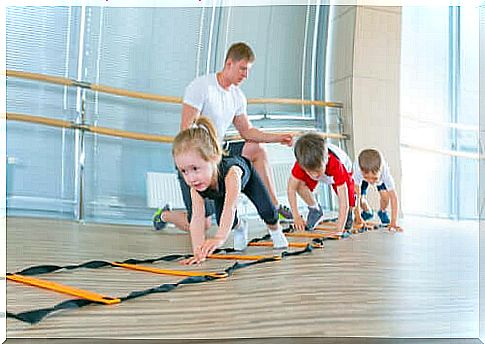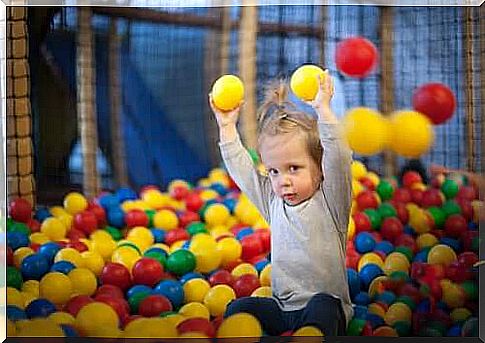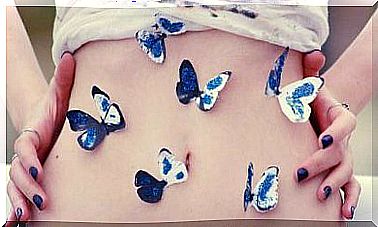Psychomotricity In Childhood: Observation And Intervention

The concept of psychomotricity in society, in many cases, is diffuse. Many people think that this child’s skill is just knowing how to move properly. However, the importance of psychomotricity in child development goes far beyond that.
Good psychomotricity is usually the prelude to the correct acquisition of language and its proper use in communication in interactions with others. Therefore, the term psychomotricity integrates the cognitive, emotional, symbolic and sensorimotor interactions that operate in children throughout their cognitive, motor and emotional development.
Interventions aimed at improving psychomotricity work, as we will see below, from aspects of all these elements:
- Motors: balance, laterality, coordination.
- Cognitive: perception, representation and creativity.
- Affective-relational: acquisition of limits, regulation of impatience, emotions, security.

How to stimulate psychomotricity
In Kindergarten, psychomotor activity – the bodily experience in relation to adults and peers, objects and space – is fundamental for the child’s good development.
The activities to develop psychomotricity should be, therefore, attractive, varied, motivating, pleasurable and playful. In this section, we’ll look at some fundamental ideas for getting good psychomotor stimulation:
1. Adult space, materials and role
The material has to be varied and suitable for the child’s age. In addition, both the educator and the space used in the classes have to accompany the children in their games and their movement. The most suitable points to create a psychomotricity space are as follows:
- Space: it must be a safe environment. At the same time, it should be stimulating enough for children to develop the skills that interest us.
- Materials: the more variety of materials there is in the classroom, the greater the psychomotor development of children.
- The role of the adult: the teacher must have the capacity for observation and listening, and for verbal and non-verbal communication. Also, it’s critical to have a good attitude and get involved in the game.
2. Structure of sessions
In order for children to take full advantage of psychomotricity sessions, it is very important that they follow a structure thought out in advance. Therefore, teachers should plan exactly what kind of activities they want to do during classes.
On the other hand, it is also good to let the little ones improvise what they want to do in some situations. This space of freedom must not deviate from the basic norm: the teacher must maintain leadership at all times.
3. Importance of play
Play, contrary to what it might seem, is one of the most useful activities that children can do. It is useful for hundreds of things: to explore the space around you, to learn rules, to create, to experiment, to relate to others of the same age…
There are different types of games. Each one of them will have a distinct role within the psychomotricity sessions, but all of them can be useful to achieve some goal. Therefore, they should become one of the main tools of those who want to stimulate these skills in the little ones.
The development of psychomotricity from 0 to 3 years
In their first years of life, children develop their psychomotricity skills in a way that, among other things, will improve their personal autonomy and their ability to relate to others.
In this section, we’ll look at how these skills evolve in the first three years of life. In this way, it will be simpler to determine whether a child’s evolution has been adequate.
From 0 to 9 months
- Keep your head up when you’re on your stomach.
- Fix your gaze and follow the movements of an object or person with your eyes.
- I smiled in response to a stimulus.
- Visually recognizes the mother or caregiver.
- Respond positively to social interactions by making some sound.
- Gets up and moves your head when you’re on your stomach.
- Rotates from the belly-up position to the sideways position and vice versa.
- He smiles and moves his legs in front of people he knows.
- Recognize your caregivers.
- It remains seated without support.
- Can stand upright with support.
- He smiles at his image in a mirror and tries to interact with it.
- She gets upset and cries when her primary caregiver leaves.
- Reacts with discomfort in front of strangers.
From 9 to 12 months
- Sit down and stand up with support.
- Crawl.
- Discover objects that have been hidden in front of you.
- Puts and takes objects out of a container.
- Take your first steps with help.
- Interacts in a loving way with other people.
- Respond when he hears your name.
Warning Signs at 12 Months
- Still can’t sit unsupported.
- Cannot hold objects with both hands.
- Don’t smile at people you know.
- You are still not interested in the things around you.
- It does not make any sound to attract attention.
- She still doesn’t cry or complain in the absence of people who are close to her.
From 12 to 24 months
- Stand up and take steps with support.
- Pushes a ball imitating an adult.
- Start using the spoon by holding it tightly.
- Start eating solids without problems.
- Freely manipulate construction games.
- Recognizes body parts.
- Can recognize unfamiliar people who belong to your daily life.
- Recognizes the objects of habitual use (spoon, towel, toys…).
- Imitates adult movements in play.
- He accepts the absence of his parents, although he may complain at first.
- Repeat actions that you find funny or that catch your attention.
- Explore and show curiosity for familiar objects.
- Drink from a glass holding it with both hands.
- Crouch to pick up objects.
- Recognizes the basic spaces of your usual environment (home, park, school…).
- Play with other children for brief moments.
- Share objects with other children when asked to do so.
- Recognize some elements of the season you are in: clothes, shoes…
Warning signs at 2 years
- Don’t walk alone.
- It still doesn’t point out the main parts of the body.
- He never approaches or shows interest in playing with other children.
- Does not recognize different very familiar spaces (kitchen, bathroom, bedroom…).
- Failure to imitate adults’ actions.
- Does not respond to hearing your name.
From 24 to 30 months
- Jump with both feet.
- Play the ball with your hands and feet.
- Take off your shoes and unbuttoned pants.
- Use the spoon and fork and drink from the glass without throwing the food.
- Recognizes the potty and toilet and uses them as indicated by the adult.
- It moves easily through the usual spaces (home, school…).
- It identifies some changes in nature corresponding to the seasons of the year.
- Recognizes the closest people in photographs.
- Plays together with children of the same age.
- Differentiate themes related to people, animals and plants in images.
- Greets children and acquaintances when asked to do so.

From 24 to 36 months
- Performs activities that require manual movements, such as screwing, snapping, threading.
- Can run and jump with a certain amount of control.
- Ask to go to the bathroom when you need to.
- Start showing preferences for some of your peers.
- Show affection for younger children and pets.
- You get to know the norms and habits of social behavior of the groups you belong to.
Warning signs when the child is 3 years old
- No need in the bathroom.
- It is unable to respond to simple orders.
- Does not identify images.
- It remains isolated. Does not show curiosity about things.
- Uses isolated words without connectors.
- Does not imitate simple lines (vertical, horizontal…).
All these warning signs are just signs that should arouse our attention to, if deemed necessary, consult a specialist who can help the child to strengthen certain abilities.
However, there’s no need to worry too much if your children haven’t reached the normative age milestones. With timely intervention, most delays in a healthy child’s cognitive development are easily repairable.









